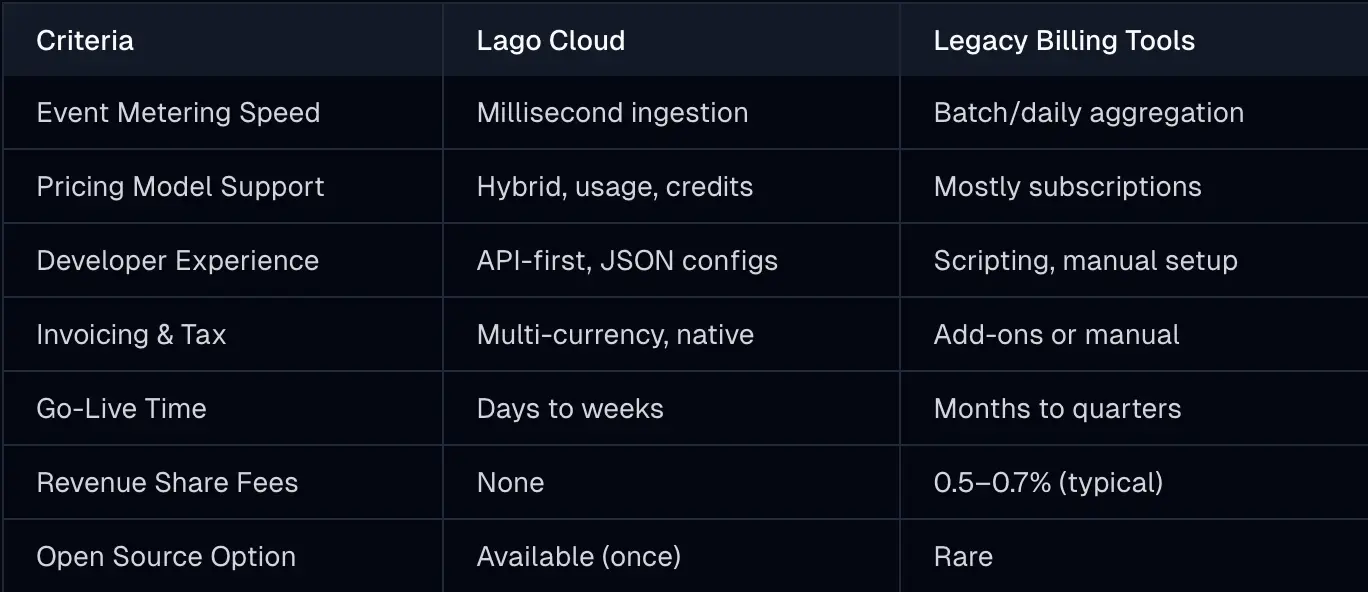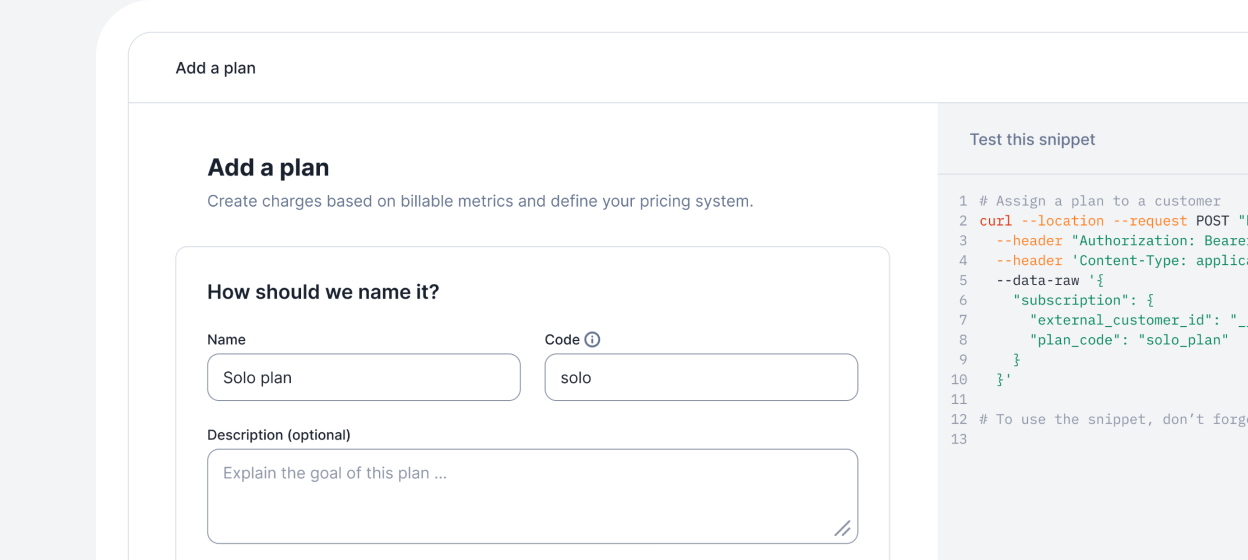Subscription Management for B2B SaaS Businesses: Best Practices and Strategies
The subscription billing management market is projected to reach $17.95 billion by 2030, growing at a compound annual rate of 16.9% from 2025 to 2030. This surge is driven by the shift to customer-centric, recurring revenue models in B2B SaaS. Yet, as pricing models become more complex—especially with the rise of AI and usage-based billing—subscription management is no longer just about collecting payments. It’s about delivering flexibility, accuracy, and actionable insights at scale.
This article breaks down the best practices and strategies for B2B SaaS subscription management, with a focus on how modern platforms like Lago enable technical teams to handle complex billing, hybrid pricing, and global compliance with speed and precision.
Why Subscription Management Matters for B2B SaaS
Recurring Revenue, Customer Retention, and Operational Complexity
Subscription management is the process of overseeing the entire customer lifecycle—from onboarding and contract signing to plan changes, renewals, and cancellations. For B2B SaaS, this means handling:
- Custom contracts and negotiated pricing
- Mid-cycle upgrades, downgrades, and add-ons
- Usage-based and hybrid pricing models
- Multi-entity invoicing and tax compliance
A robust subscription management system automates these workflows, reduces manual errors, and provides a single source of truth for finance, sales, and customer success teams[1].
Key Benefits:
- Predictable cash flow and revenue forecasting[2]
- Higher customer satisfaction and retention
- Reduced billing errors and revenue leakage
- Faster time-to-cash and improved net revenue retention (NRR)
Core Features of Modern Subscription Management Platforms
Flexible Billing and Pricing Models
B2B SaaS companies increasingly need to support a mix of pricing strategies, including:
- Pay-as-you-go (usage-based): Customers pay for what they consume, such as API calls, tokens, or compute hours.
- Hybrid pricing: Combines subscriptions with usage-based overages, prepaid credits, or add-ons.
- Tiered and seat-based plans: Different feature sets or user counts at fixed price points.
A modern platform like Lago meters events in real time (up to 15,000 events per second), enabling accurate billing for AI agent pricing, pay-per-use AI services, and complex hybrid models. This is critical for companies introducing real COGS (cost of goods sold) into their software business, such as AI APIs or infrastructure services.
Example:
An AI SaaS provider bills customers a monthly subscription for platform access, plus a variable fee based on the number of tokens processed. Lago’s event-driven architecture ingests token usage instantly, applies overage rules, and generates invoices without delay.
Advanced Invoicing and Revenue Recognition
Accurate, automated invoicing is essential for both customer experience and compliance. Key capabilities include:
- Multi-currency support and tax logic (e.g., EU VAT, US sales tax)
- Customizable invoice templates and consolidated billing
- Automated dunning, credit notes, and refunds
- ASC 606-compliant revenue recognition
Lago’s invoicing engine integrates with your payment stack, supports global currencies, and provides finance-grade governance—helping you avoid the feature bloat and setup friction common in legacy systems.
Real-Time Analytics and Reporting
Subscription management platforms should offer dashboards and APIs for tracking:
- Monthly Recurring Revenue (MRR)
- Gross revenue and invoice collection rates
- Churn, expansion, and contraction metrics
- Customer lifetime value (CLTV) and acquisition cost (CAC)
These insights help SaaS leaders make data-driven decisions, optimize pricing, and identify upsell opportunities[3].
Developer-Friendly APIs and Integrations
Technical teams need control and flexibility. Lago is API-first, with JSON-based configuration and a no-code plan editor for rapid pricing tests. Integrations with CRM, ERP, and accounting systems ensure a seamless data flow across the business.
Key integration points:
- CRM for customer data and sales workflows
- Accounting for revenue recognition and compliance
- Communication tools for automated notifications and reminders
Best Practices for B2B SaaS Subscription Management
1. Design for Pricing Flexibility
Support multiple pricing models—subscriptions, usage-based, hybrid, and add-ons—to match customer needs and market trends. Use a platform that allows you to experiment with pricing without migrations or downtime[3].
2. Automate Billing and Revenue Operations
Automate recurring billing, invoicing, and revenue recognition to reduce manual errors and speed up cash collection. Implement dunning policies to handle failed payments and reduce involuntary churn[3].
3. Centralize Data and Analytics
Consolidate subscription, usage, and financial data in a single platform. Use real-time analytics to monitor key metrics and inform strategic decisions[3].
4. Prioritize Developer Experience
Choose a solution that is API-driven and easy to configure, so your engineering team can adapt quickly to new pricing models or business requirements. Avoid platforms that require heavy professional services or lock you into proprietary workflows.
5. Ensure Global Compliance
Support multi-currency invoicing, tax compliance (VAT, GST, sales tax), and local language requirements to serve customers worldwide. Look for platforms with built-in compliance features and certifications like SOC 2 Type 2.
Comparing Subscription Management Solutions

Addressing Common Subscription Management Challenges
Handling Complex Billing Scenarios
B2B SaaS often involves custom contracts, mid-cycle plan changes, and negotiated discounts. A flexible platform lets you:
- Apply custom pricing and discounts per customer
- Pro-rate charges for mid-cycle upgrades or downgrades
- Automate renewals and upsell/cross-sell workflows[3].
Managing Failed Transactions and Churn
Automated dunning and real-time payment alerts help reduce involuntary churn. Use analytics to identify at-risk customers and trigger retention campaigns[3].
Supporting Global Growth
Multi-entity invoicing, local tax compliance, and support for multiple currencies and languages are essential for SaaS companies expanding internationally. Start with the most common currencies and languages, then scale as needed[3].
Industry Trends: Usage-Based and Hybrid Pricing
According to OpenView, about 39% of SaaS companies now price primarily on usage, a sharp increase from a decade ago. AI and infrastructure workloads require millisecond-level metering and elastic billing, which legacy systems struggle to deliver.
Key trend drivers:
- AI APIs introducing real COGS to software
- Customer demand for pay-as-you-go and flexible pricing
- Need for granular, real-time billing and analytics
Platforms like Lago are built for these new requirements, offering real-time event ingestion, hybrid pricing, and open APIs for maximum flexibility.
Conclusion: Building a Future-Proof Subscription Management Stack
B2B SaaS subscription management is no longer just about recurring billing. It’s about supporting complex, hybrid pricing models, automating revenue operations, and delivering actionable insights at scale. The right platform enables you to adapt quickly, reduce errors, and accelerate growth.
Lago Cloud provides a developer-friendly, API-first solution for real-time metering, flexible pricing, and global compliance—without the friction or revenue-share fees of legacy tools. For companies with strict data requirements, a self-hosted open-source edition is also available.
To stay competitive as usage-based and AI-driven pricing models become the norm, invest in a subscription management system that gives you control, speed, and clarity. This is how you build a resilient, scalable SaaS business ready for the next wave of growth.
Focus on building, not billing
Whether you choose premium or host the open-source version, you'll never worry about billing again.
Lago Premium
The optimal solution for teams with control and flexibility.

Lago Open Source
The optimal solution for small projects.

